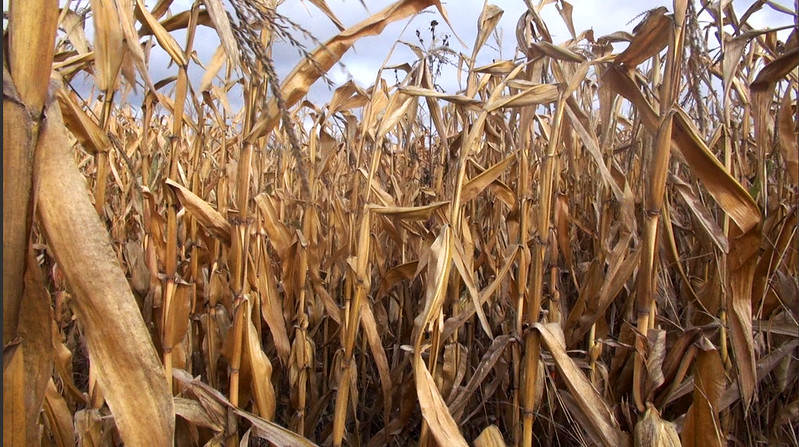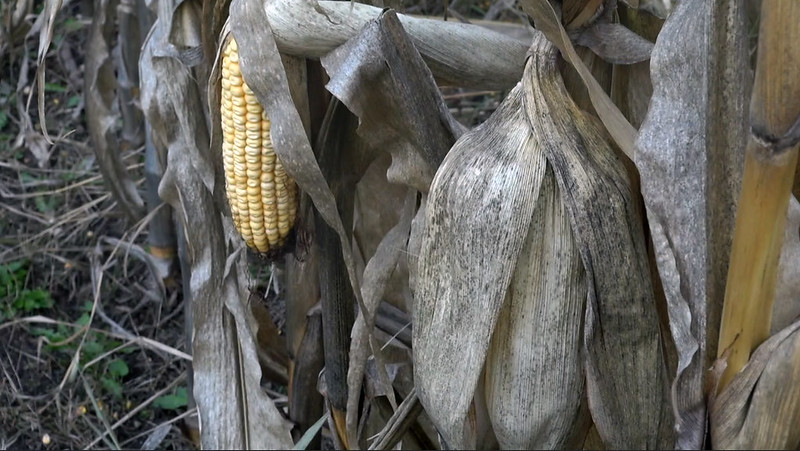The Controversial Workhorse
CAMBRIA, Wis. — On a cold winter afternoon inside the Didion grain mill in this heartland town, bags labeled, “A gift from the American people” are being filled with a yellow, flour-like substance called corn soy blend.
You can’t find corn soy blend on the shelves of any American food store. But for half a century, the mix of corn and soy beans that are grown and milled here in central Wisconsin has been one of the most popular products that America sends overseas as food aid. Corn soy blend is mixed with water or oil to serve as a meal, primarily for young children and adults with health problems, in countries experiencing conflict, disaster or food shortage.
“It is the universal food that can be used in so many cases,’’ says Paul Green, export consultant at the North American Millers Association, an advocacy group that represents mills. “That has been why it has saved so many millions of lives over the years and brought people back from virtual starvation.”
Dow Didion, president of Didion Milling, also thinks everybody wins with corn soy blend, or CSB, as it’s commonly known, and domestically produced food aid products like it.
“Certainly [food aid] provides a market for U.S. grains grown by U.S. farmers, and it provides transportation opportunities for transportation companies, [and] jobs and tax revenue for local communities — and it also provides a better quality product because of the standards that we operate under,’’ Didion said.









(Laurel White & Mackenzie Allen/MEDILL)
But not everyone agrees.
Critics say CSB is emblematic of serious problems in the U.S. Food for Peace program, the centerpiece of the U.S. effort to send emergency and developmental food aid to starving people around the world. Those critics’ concerns are centered on the idea that American-made products like CSB don’t serve the best interests of aid recipients because they take too long and cost too much to ship overseas.
For example, in August 2013, USAID paid $800,000 for 1,100 metric tons of CSB, then $183,000 to ship it overseas to South Africa. Opponents would rather the U.S. government purchase a corn soy blend product overseas, closer to a disaster or conflict site, saving shipping costs.
Virtually all other countries, including the U.K. and Canada, as well as the United Nations, long ago moved to that system.
However, critics, including some current and former U.S. aid officials, don’t just oppose buying and shipping CSB made in America – they oppose it as a staple of American food aid entirely.
“It’s kind of a lousy product to begin with,” said Dean Jensen, who was chief quality auditor at the U.S. Department of Agriculture’s food aid procurement office for more than 20 years. “There are a whole bunch of people who buy it who wouldn’t put it in their mouth.”
Accusations and concerns
In 2010, the influential international aid group Doctors Without Borders sent a letter to then-Secretary of State Hillary Clinton, USAID Administrator Rajiv Shah and Secretary of Agriculture Tom Vilsack calling CSB “substandard” and asking the U.S. government to stop sending the product to developing countries.
“Despite some recent gains in the fight against childhood malnutrition, the global food aid system—led by the United States—largely continues to provide substandard foods to millions of malnourished children every year,” the letter read. The organization said the foods were substandard because they didn’t provide the nutrients and protein that starving children need.
In 2009, the year before Doctors Without Borders sent its letter, USAID commissioned Tufts University to conduct a two-year study examining the nutritional quality of food aid products. The study was initiated because the U.S. government concluded it hadn’t done a good, scientifically based review of CSB, said Tufts professor Dr. Beatrice Rogers.
Prior to that study, CSB had undergone more than 10 reformulations in its roughly five decades of existence. Those changes were made at the suggestion of various groups, from USDA task forces to nonprofits like The Institute of Medicine, an independent nonprofit that conducts health and health care studies at the request of Congress, federal agencies and independent organizations.
These groups develop new formulas for CSB through testing, then USAID makes changes to their Commodity Reference Guide accordingly and processors, like Didion, begin to manufacture CSB to match the new formula.
Dr. David Hamer, professor of international health and medicine at Boston University, says those new versions of CSB reflect attempts by the government to stay current with ever-changing nutrition science.
“Our understanding of the role of certain micronutrients … [has] evolved a lot, even in the last two decades,” Hamer said.
The most recent updates to CSB, recommended by Tufts, are currently being tested in Malawi, Burkina Faso and Sierra Leone. They include packaging vegetable oil with the product, the addition of whey and small vitamin and mineral tweaks.
Even these changes may not be enough to win over some critics.
“Our major concern is [ensuring] that the product is nutritionally appropriate for the needs of children,” said Kevin P. Q. Phelan, nutrition working group leader at Doctors Without Borders. “The new formulations are taking steps in that direction, but a lot more ground needs to be covered.”
Quality control problems
In addition to possible nutritional deficiencies, some have criticized CSB for having consistent quality control problems.
“If you were to do a historical search of USDA’s quality feedback database going back to 30 years, CSB has always been a problem,” said Jensen, the former USDA food procurement official who worked in the office from the mid-‘80s until about five years ago.
How CSB came to be
Corn soy blend as it exists today has been more than 100 years in the making.
Corn soy milk, the U.S. food aid product that evolved into CSB, was inspired by a product called soy flour, which was first produced in the U.S. in the early 20th century and became popular during World Wars I and II and the Great Depression as a cheap source of protein.
When corn soy milk was developed in the 1950s as a food aid product, corn and soy were available in abundance. The tastier corn was used to offset the less appealing flavor of the soy. Corn and soy were also a great combination because corn provided carbohydrates and soy provided protein, making the product nutritious.
Though it was nutritious, corn soy milk reflected the early goals of the entire Food for Peace program: to offload surplus crops and create overseas markets for U.S. crops.
Corn and soy are no longer in surplus in the United States.
The first shipment of corn soy milk was sent overseas in 1966. In 1974, Africa alone received more than 22,000 tons of it. Corn soy milk continued to grow in popularity, and by 1980, Food for Peace had cumulatively purchased more than 1.3 million tons of it to send to hungry people abroad. In 1989, milk was removed from the product due to a dwindling surplus and rising cost, and corn soy milk became “corn soy blend.”
According to a USA Today/Medill analysis of USDA and USAID data from 2004 though 2013, corn soy blend has maintained a steady presence in the Food for Peace program, regularly clocking in at about five percent of the food American sends abroad as aid. In 2012, it was the seventh most popular food aid product.
According to the data, America sent 55,000 metric tons of corn soy blend to countries like Tanzania, Ethiopia and Malawi last year. That is 121.3 million pounds, or enough to fill 36 Olympic-sized swimming pools.
In 2007, the Government Accountability Office published a report that criticized corn soy blend as having significant quality control problems, like mixing the wrong amount of vitamins and minerals, mold and spoilage overseas and contamination with rodent feces. In response, in September 2009, the USDA resumed quality assurance activities like inspections of processing facilities and testing and sampling of products.
The federal agency had stopped such oversight efforts in 1999, instead moving to a system called Total Quality Systems Audit (TQSA) that relied on a baseline inspection of facilities and the possibility of two additional audits per year, which they believed to be more effective and efficient.
Before those oversight efforts were reinstated, some shipments of CSB to Kenya and Haiti in 2009 were found by United Nations World Food Programme lab tests to be inedible. A shipment to Kenya was found to be “rancid, acidic and unpalatable,” according to the GAO, the independent watchdog agency of Congress. Aid workers were tipped off to the problems because of complaints that the product tasted bitter.
Other 2009 shipments to Guatemala and Haiti delivered before quality controls were re-established were contaminated with mycotoxins, a form of toxic mold that can be fatal. That incident cost USAID over $30,000 in testing and led to the non-profit distributing the food to cease the distribution of more than 40,000 metric tons of CSB in eight countries. Afterward, USAID established new testing protocols for mycotoxins.
Working to support CSB
Earlier this year, legislation that could reduce the amount of American-made CSB that Washington buys as food aid made its way around Capitol Hill. And CSB processors continue lobbying to support that portion of their business.
There used to be five companies making CSB, but now there are only two: Didion and the agricultural giant Bunge, of New York. In 2012, Didion was awarded more than 80 percent of the government’s corn soy blend contracts, totaling more than $37 million, according to data provided by the USDA.
Didion, which started producing CSB in the early 1990s, has been lobbying since at least 2005, spending $220,000 since 2010, according to their lobbying disclosure forms and data provided by Open Secrets, a nonpartisan, independent nonprofit that tracks money in U.S. politics. Its lobbying firm, Olsson, Frank & Weeda, lists promoting the purchase of American products like CSB for international food aid as one of the mill’s primary issues.
Bunge sold about $6 million of corn soy blend to the U.S. government for food aid programs in the 2012 fiscal year – a meager amount in comparison to its 2011 revenues of nearly $60 billion. However, Bunge makes money from other food aid products – Bunge, ADM and Cargill together supplied 30 percent of U.S. international food aid in 2012 – and has done lobbying to promote American-made food aid products in recent years, along with other issues. They spent more than $1 million on lobbying that year, and similar amounts in 2012 and 2013, according to lobbying disclosure forms.
Working alongside Didion and Bunge in support of CSB is the North American Millers Association. NAMA’s advocacy work surrounding CSB focuses on trying to convince those private volunteer organizations distributing food aid on the ground to continue using it.
Despite the fact that CSB is primarily served as a porridge or gruel and fed to young children, NAMA includes recipes on its website for more palatable foods like “banana cake.”
“Not all areas are familiar with our foods, so we try to provide a source of some kind of palatable, interesting food products … other than just the standard mush,” NAMA’s Green said.
The Future of CSB
The future of corn soy blend will be influenced by the outcome of continuing food aid reform discussions in Congress. But it will also depend on how CSB fares in the increasingly competitive marketplace of food aid products.
A recently developed food aid product called RUSF (Ready to Use Supplementary Food) was first purchased by USAID in 2013, according to a Medill/USA Today analysis of USDA data. RUSFs were designed to prevent malnutrition in the same populations that CSB is meant to target: Vulnerable individuals like young children, nursing mothers and HIV/AIDS patients. RUSFs were born, in a way, with the invention of the first supplementary food in 1997, called Plumpy’nut. Since that product’s invention, the humanitarian aid community has exploded with efforts to create similar products.
Some, including Doctors Without Borders and a few scientific studies, say that RUSFs are more effective than CSB at treating these populations because they provide more nutrients and protein. (These studies were conducted with CSB formulas in use prior to the Tufts study.) Regardless, it doesn’t seem like RUSFs will be replacing CSB any time soon – primarily because the newer products are much more expensive. In June 2013, the government paid around $700 per metric ton for corn soy blend and about $3,000 per metric ton for an RUSF, according to USDA data.
And so some industry insiders believe that CSB in its newest, most improved form has a safe place in the Food for Peace program.
Nelson Randall, retired chief of the international procurement division at the USDA, also believes CSB has improved its way to a certain future.
“You won’t see the CSB as it used to be,” said Randall, who is now a food aid consultant. “It’s graduated, so to speak, to a better product. I think it will continue to be used in the enhanced versions for years to come.”
And so those bags of corn soy blend continue to roll down Didion’s assembly line in rural Wisconsin, providing jobs to American workers – and a food aid product for hungry people on the other side of the world.
